ALLORA & CALZADILLA'S FABLE ON LISTENING
La Casa Encendida is planning a large part of its artistic, exhibition program this season around the concept of Verbos encendidos, a framework line of argument that frames the theme and the perspective from which certain public, political and social issues are approached from the institution. Escuchar (Listen) is the first verb, chosen to start with it a call for attention towards the construction of spaces and tools that allow to overcome differences and find common spaces of understanding.
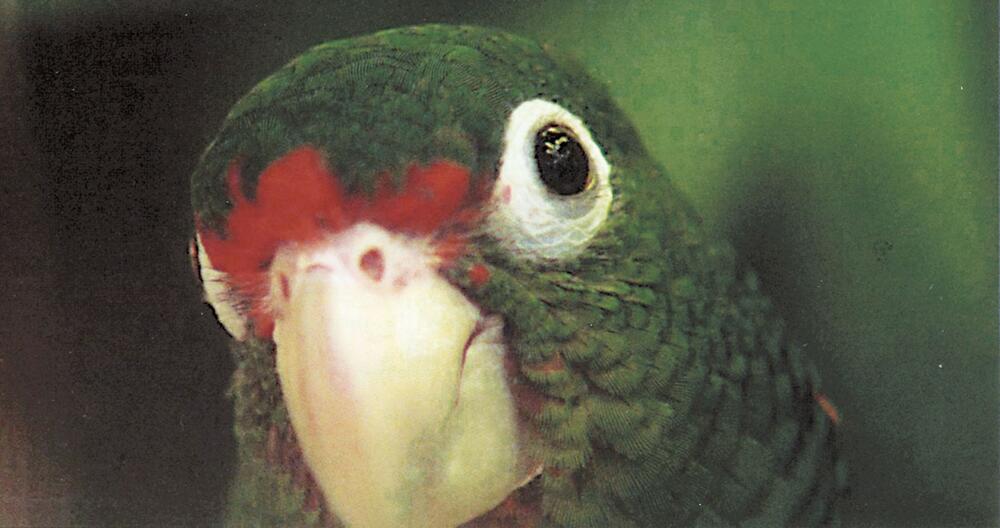
Within that first wave of initiatives, the center welcomes in its halls the always interesting El gran silencio (2014), the video installation by Allora & Calzadilla that becomes a fable and an exquisite narration that digresses on the human desire to search and look beyond what surrounds him, increasing the progressive disinterest in what is closest to him and forgetting the basics of listening and dialogue.
Consisting of three panels, the proposal, known in Spain after its passage through other iconic spaces in the last decade, is built as an invitation to the viewer to join a dialogue between apparently surrounding worlds and whose concept is narrated from the work of writer Ted Chiang.
While simultaneously entering the artificial environments of the Arecibo Observatory's technology -which transmits and receives waves focusing on the universe-, and the natural environments of the complex's site -a jungle that serves as home to the last wild population of Puerto Rican parrots-, the script unfolds on the viewer spinning on the concept of listening, but also on the disengagement and distancing from what unites us.
The story presents the parrots' observations of their environment, of how human beings strive for an eventual, and unsafe, contact with the universe when they abandon their own. Entwined in this paradox, the fable transcends and encourages, precisely, that listening that underlies the analysis of speech, sound and a common physiognomy, close in its environment, but distant in its possibilities.
Allora & Calzadilla. El Gran Silencio can be seen until June 16 at Sala A of La Casa Encendida, Ronda de Valencia, 2, Madrid (Spain).
Related Topics
May interest you
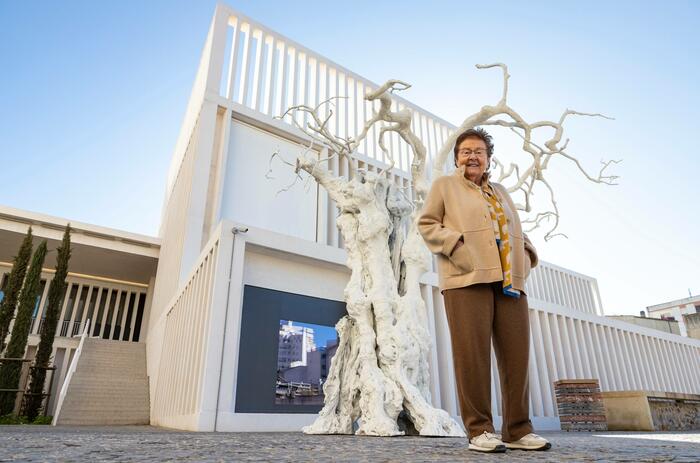
Helga de Alvear (Kirn/Nahe, Germany, 1936-Madrid, Spain, 2025) passed away at the age of 88. A fundamental figure of collecting and gallerism in Spain and Europe, her name remains as a metaphorical vocative and reference of one of the keys to the evolution and understanding of how contemporary art should be shared and communicated to facilitate its appreciation as a fundamental part of the times in which she lived. A true believer that artistic practices should come to the surface and be another representation of the motifs and realities that shaped each period of history, convulsive in the case of Spain, she approached it with the vision and experience of someone who finds a necessary space to appreciate the present and build a future.
IN MEMORY OF HELGA DE ALVEAR
Helga de Alvear (Kirn/Nahe, Germany, 1936-Madrid, Spain, 2025) passed away at the age of 88. A fundamental figure of collecting and gallerism in Spain and Europe, her name remains as a metaphorical vocative and reference of one of the keys to the evolution and understanding of how contemporary art should be shared and communicated to facilitate its appreciation as a fundamental part of the times in which she lived. A true believer that artistic practices should come to the surface and be another representation of the motifs and realities that shaped each period of history, convulsive in the case of Spain, she approached it with the vision and experience of someone who finds a necessary space to appreciate the present and build a future.

Helga de Alvear (Kirn/Nahe, Germany, 1936-Madrid, Spain, 2025) passed away at the age of 88. A fundamental figure of collecting and gallerism in Spain and Europe, her name remains as a metaphorical vocative and reference of one of the keys to the evolution and understanding of how contemporary art should be shared and communicated to facilitate its appreciation as a fundamental part of the times in which she lived. A true believer that artistic practices should come to the surface and be another representation of the motifs and realities that shaped each period of history, convulsive in the case of Spain, she approached it with the vision and experience of someone who finds a necessary space to appreciate the present and build a future.
IN MEMORY OF HELGA DE ALVEAR
Helga de Alvear (Kirn/Nahe, Germany, 1936-Madrid, Spain, 2025) passed away at the age of 88. A fundamental figure of collecting and gallerism in Spain and Europe, her name remains as a metaphorical vocative and reference of one of the keys to the evolution and understanding of how contemporary art should be shared and communicated to facilitate its appreciation as a fundamental part of the times in which she lived. A true believer that artistic practices should come to the surface and be another representation of the motifs and realities that shaped each period of history, convulsive in the case of Spain, she approached it with the vision and experience of someone who finds a necessary space to appreciate the present and build a future.
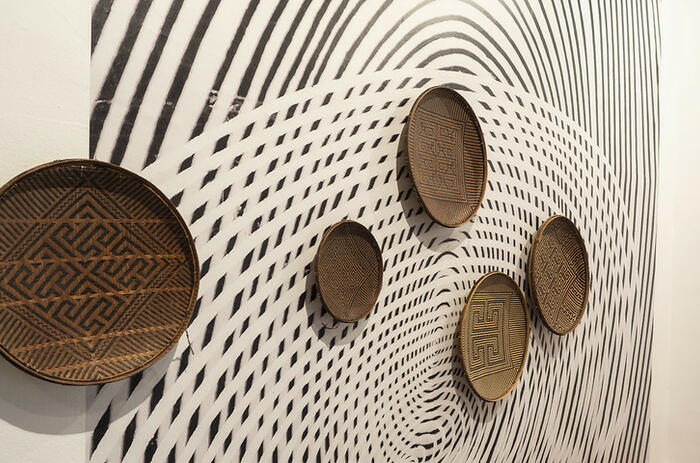
Casa de América, in Madrid, hosts Convergences / Divergences. Two Aesthetics in Dialogue, a complete exhibition curated by Ariel Jimenez in which Ye'kwana craftsmanship, a community of the Venezuelan Amazon rainforest, and modern and contemporary geometric abstraction, represented by more than a hundred works from the Juan Carlos Maldonado Collection, are in dialogue. The exhibition delves into the relationship between the different aesthetics developed contemporarily by both groups and, above all, highlights the reference to modern art movements and their partial debt to the techniques and motifs of the peoples of the Amazon.
DIALOGUE BETWEEN GEOMETRIC ABSTRACTION AND AMAZON AT CASA DE AMERICA
Casa de América, in Madrid, hosts Convergences / Divergences. Two Aesthetics in Dialogue, a complete exhibition curated by Ariel Jimenez in which Ye'kwana craftsmanship, a community of the Venezuelan Amazon rainforest, and modern and contemporary geometric abstraction, represented by more than a hundred works from the Juan Carlos Maldonado Collection, are in dialogue. The exhibition delves into the relationship between the different aesthetics developed contemporarily by both groups and, above all, highlights the reference to modern art movements and their partial debt to the techniques and motifs of the peoples of the Amazon.
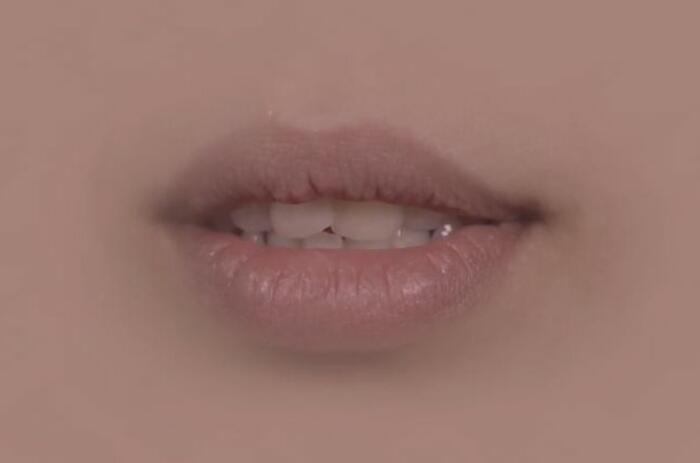
The work that Lúa Coderch (Iquitos, Peru, 1982) has been doing around language takes over her recent solo show at Madrid's The Ryder Projects to consolidate a new relational vision of communicative practices. Exhausted and exuberant, title of this partially retrospective and almost thesis exhibition, also responds to the two apparently opposite moods, but with an inexorable link, of the vital needs that seep into contemporary society between individuals and a certain extimacy that, organically, seems to have been imposed.
LANGUAGE AND SOCIETY IN LÚA CODERCH'S WORK AT THE RYDER
The work that Lúa Coderch (Iquitos, Peru, 1982) has been doing around language takes over her recent solo show at Madrid's The Ryder Projects to consolidate a new relational vision of communicative practices. Exhausted and exuberant, title of this partially retrospective and almost thesis exhibition, also responds to the two apparently opposite moods, but with an inexorable link, of the vital needs that seep into contemporary society between individuals and a certain extimacy that, organically, seems to have been imposed.
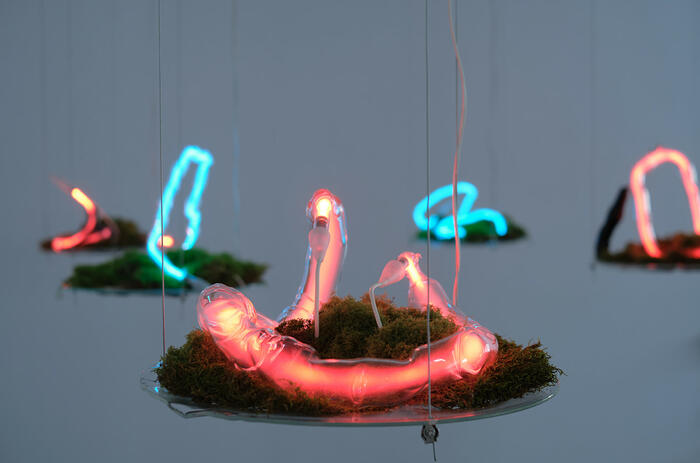
The proposal of Día Muñoz (Guayaquil, Ecuador, 1989) goes through the materialized ideas of a posthumanist future from a speculative perspective in his recent exhibition “Creaturas” de la dimensión de lo inconsciente (Creatures from the dimension of the unconscious) at the Madrid-based Ponce+Robles. To this end, she concentrates on the scientific possibilities and the multiple options of resolution, starting from organic principles with which to operate and create those dimensions of biological character and fundamentally technical essence.
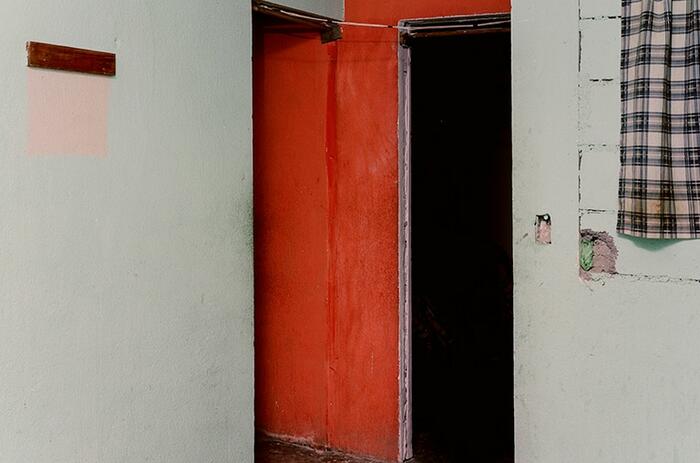
Felipe Romero (Bogota, Colombia, 1992) usually shows in his photographic proposal a high interest in conflict zones. While the scenario reflects this palpable but still intangible tension, it also serves as a reflective framework where the conflict and its protagonists meet.
BORDER HOPELESSNESS THROUGH THE LENS OF FELIPE ROMERO
Felipe Romero (Bogota, Colombia, 1992) usually shows in his photographic proposal a high interest in conflict zones. While the scenario reflects this palpable but still intangible tension, it also serves as a reflective framework where the conflict and its protagonists meet.
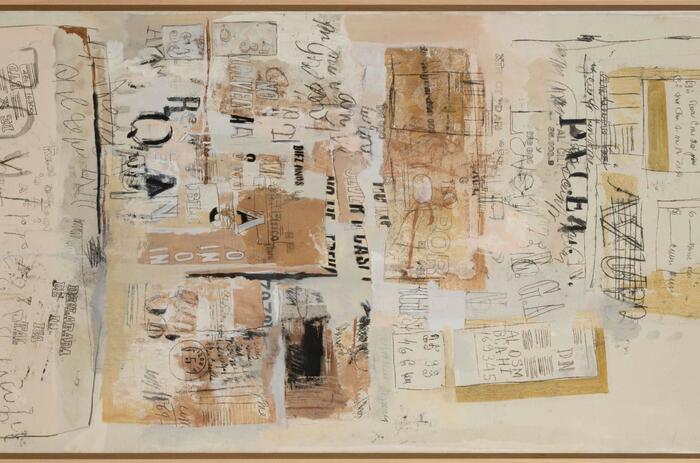
Madrid-based Maisterravalbuena proposes a vindication of the work of Sarah Grilo (Buenos Aires, Argentina,1917 - Madrid, Spain, 2007) through Soluciones para pensar, the second exhibition on this artist at the gallery. With a didactic and rediscovery vocation, the exhibition gathers a selection of paintings in different formats made between the 1960s and 1990s, many of them unpublished to the public. This work of selection and direct work of the gallery with the archive and the legacy of the Argentinean artist becomes fundamental in the structuring of the objective of creating opportunities for a greater knowledge of Grilo's work.
(RE)DISCOVERING SARAH GRILO AT MAISTERRAVALBUENA
Madrid-based Maisterravalbuena proposes a vindication of the work of Sarah Grilo (Buenos Aires, Argentina,1917 - Madrid, Spain, 2007) through Soluciones para pensar, the second exhibition on this artist at the gallery. With a didactic and rediscovery vocation, the exhibition gathers a selection of paintings in different formats made between the 1960s and 1990s, many of them unpublished to the public. This work of selection and direct work of the gallery with the archive and the legacy of the Argentinean artist becomes fundamental in the structuring of the objective of creating opportunities for a greater knowledge of Grilo's work.

Helga de Alvear (Kirn/Nahe, Germany, 1936-Madrid, Spain, 2025) passed away at the age of 88. A fundamental figure of collecting and gallerism in Spain and Europe, her name remains as a metaphorical vocative and reference of one of the keys to the evolution and understanding of how contemporary art should be shared and communicated to facilitate its appreciation as a fundamental part of the times in which she lived. A true believer that artistic practices should come to the surface and be another representation of the motifs and realities that shaped each period of history, convulsive in the case of Spain, she approached it with the vision and experience of someone who finds a necessary space to appreciate the present and build a future.
IN MEMORY OF HELGA DE ALVEAR
Helga de Alvear (Kirn/Nahe, Germany, 1936-Madrid, Spain, 2025) passed away at the age of 88. A fundamental figure of collecting and gallerism in Spain and Europe, her name remains as a metaphorical vocative and reference of one of the keys to the evolution and understanding of how contemporary art should be shared and communicated to facilitate its appreciation as a fundamental part of the times in which she lived. A true believer that artistic practices should come to the surface and be another representation of the motifs and realities that shaped each period of history, convulsive in the case of Spain, she approached it with the vision and experience of someone who finds a necessary space to appreciate the present and build a future.

Casa de América, in Madrid, hosts Convergences / Divergences. Two Aesthetics in Dialogue, a complete exhibition curated by Ariel Jimenez in which Ye'kwana craftsmanship, a community of the Venezuelan Amazon rainforest, and modern and contemporary geometric abstraction, represented by more than a hundred works from the Juan Carlos Maldonado Collection, are in dialogue. The exhibition delves into the relationship between the different aesthetics developed contemporarily by both groups and, above all, highlights the reference to modern art movements and their partial debt to the techniques and motifs of the peoples of the Amazon.
DIALOGUE BETWEEN GEOMETRIC ABSTRACTION AND AMAZON AT CASA DE AMERICA
Casa de América, in Madrid, hosts Convergences / Divergences. Two Aesthetics in Dialogue, a complete exhibition curated by Ariel Jimenez in which Ye'kwana craftsmanship, a community of the Venezuelan Amazon rainforest, and modern and contemporary geometric abstraction, represented by more than a hundred works from the Juan Carlos Maldonado Collection, are in dialogue. The exhibition delves into the relationship between the different aesthetics developed contemporarily by both groups and, above all, highlights the reference to modern art movements and their partial debt to the techniques and motifs of the peoples of the Amazon.

The work that Lúa Coderch (Iquitos, Peru, 1982) has been doing around language takes over her recent solo show at Madrid's The Ryder Projects to consolidate a new relational vision of communicative practices. Exhausted and exuberant, title of this partially retrospective and almost thesis exhibition, also responds to the two apparently opposite moods, but with an inexorable link, of the vital needs that seep into contemporary society between individuals and a certain extimacy that, organically, seems to have been imposed.
LANGUAGE AND SOCIETY IN LÚA CODERCH'S WORK AT THE RYDER
The work that Lúa Coderch (Iquitos, Peru, 1982) has been doing around language takes over her recent solo show at Madrid's The Ryder Projects to consolidate a new relational vision of communicative practices. Exhausted and exuberant, title of this partially retrospective and almost thesis exhibition, also responds to the two apparently opposite moods, but with an inexorable link, of the vital needs that seep into contemporary society between individuals and a certain extimacy that, organically, seems to have been imposed.

The proposal of Día Muñoz (Guayaquil, Ecuador, 1989) goes through the materialized ideas of a posthumanist future from a speculative perspective in his recent exhibition “Creaturas” de la dimensión de lo inconsciente (Creatures from the dimension of the unconscious) at the Madrid-based Ponce+Robles. To this end, she concentrates on the scientific possibilities and the multiple options of resolution, starting from organic principles with which to operate and create those dimensions of biological character and fundamentally technical essence.

Felipe Romero (Bogota, Colombia, 1992) usually shows in his photographic proposal a high interest in conflict zones. While the scenario reflects this palpable but still intangible tension, it also serves as a reflective framework where the conflict and its protagonists meet.
BORDER HOPELESSNESS THROUGH THE LENS OF FELIPE ROMERO
Felipe Romero (Bogota, Colombia, 1992) usually shows in his photographic proposal a high interest in conflict zones. While the scenario reflects this palpable but still intangible tension, it also serves as a reflective framework where the conflict and its protagonists meet.

Madrid-based Maisterravalbuena proposes a vindication of the work of Sarah Grilo (Buenos Aires, Argentina,1917 - Madrid, Spain, 2007) through Soluciones para pensar, the second exhibition on this artist at the gallery. With a didactic and rediscovery vocation, the exhibition gathers a selection of paintings in different formats made between the 1960s and 1990s, many of them unpublished to the public. This work of selection and direct work of the gallery with the archive and the legacy of the Argentinean artist becomes fundamental in the structuring of the objective of creating opportunities for a greater knowledge of Grilo's work.
(RE)DISCOVERING SARAH GRILO AT MAISTERRAVALBUENA
Madrid-based Maisterravalbuena proposes a vindication of the work of Sarah Grilo (Buenos Aires, Argentina,1917 - Madrid, Spain, 2007) through Soluciones para pensar, the second exhibition on this artist at the gallery. With a didactic and rediscovery vocation, the exhibition gathers a selection of paintings in different formats made between the 1960s and 1990s, many of them unpublished to the public. This work of selection and direct work of the gallery with the archive and the legacy of the Argentinean artist becomes fundamental in the structuring of the objective of creating opportunities for a greater knowledge of Grilo's work.

Helga de Alvear (Kirn/Nahe, Germany, 1936-Madrid, Spain, 2025) passed away at the age of 88. A fundamental figure of collecting and gallerism in Spain and Europe, her name remains as a metaphorical vocative and reference of one of the keys to the evolution and understanding of how contemporary art should be shared and communicated to facilitate its appreciation as a fundamental part of the times in which she lived. A true believer that artistic practices should come to the surface and be another representation of the motifs and realities that shaped each period of history, convulsive in the case of Spain, she approached it with the vision and experience of someone who finds a necessary space to appreciate the present and build a future.
IN MEMORY OF HELGA DE ALVEAR
Helga de Alvear (Kirn/Nahe, Germany, 1936-Madrid, Spain, 2025) passed away at the age of 88. A fundamental figure of collecting and gallerism in Spain and Europe, her name remains as a metaphorical vocative and reference of one of the keys to the evolution and understanding of how contemporary art should be shared and communicated to facilitate its appreciation as a fundamental part of the times in which she lived. A true believer that artistic practices should come to the surface and be another representation of the motifs and realities that shaped each period of history, convulsive in the case of Spain, she approached it with the vision and experience of someone who finds a necessary space to appreciate the present and build a future.

Casa de América, in Madrid, hosts Convergences / Divergences. Two Aesthetics in Dialogue, a complete exhibition curated by Ariel Jimenez in which Ye'kwana craftsmanship, a community of the Venezuelan Amazon rainforest, and modern and contemporary geometric abstraction, represented by more than a hundred works from the Juan Carlos Maldonado Collection, are in dialogue. The exhibition delves into the relationship between the different aesthetics developed contemporarily by both groups and, above all, highlights the reference to modern art movements and their partial debt to the techniques and motifs of the peoples of the Amazon.
DIALOGUE BETWEEN GEOMETRIC ABSTRACTION AND AMAZON AT CASA DE AMERICA
Casa de América, in Madrid, hosts Convergences / Divergences. Two Aesthetics in Dialogue, a complete exhibition curated by Ariel Jimenez in which Ye'kwana craftsmanship, a community of the Venezuelan Amazon rainforest, and modern and contemporary geometric abstraction, represented by more than a hundred works from the Juan Carlos Maldonado Collection, are in dialogue. The exhibition delves into the relationship between the different aesthetics developed contemporarily by both groups and, above all, highlights the reference to modern art movements and their partial debt to the techniques and motifs of the peoples of the Amazon.

The work that Lúa Coderch (Iquitos, Peru, 1982) has been doing around language takes over her recent solo show at Madrid's The Ryder Projects to consolidate a new relational vision of communicative practices. Exhausted and exuberant, title of this partially retrospective and almost thesis exhibition, also responds to the two apparently opposite moods, but with an inexorable link, of the vital needs that seep into contemporary society between individuals and a certain extimacy that, organically, seems to have been imposed.
LANGUAGE AND SOCIETY IN LÚA CODERCH'S WORK AT THE RYDER
The work that Lúa Coderch (Iquitos, Peru, 1982) has been doing around language takes over her recent solo show at Madrid's The Ryder Projects to consolidate a new relational vision of communicative practices. Exhausted and exuberant, title of this partially retrospective and almost thesis exhibition, also responds to the two apparently opposite moods, but with an inexorable link, of the vital needs that seep into contemporary society between individuals and a certain extimacy that, organically, seems to have been imposed.

The proposal of Día Muñoz (Guayaquil, Ecuador, 1989) goes through the materialized ideas of a posthumanist future from a speculative perspective in his recent exhibition “Creaturas” de la dimensión de lo inconsciente (Creatures from the dimension of the unconscious) at the Madrid-based Ponce+Robles. To this end, she concentrates on the scientific possibilities and the multiple options of resolution, starting from organic principles with which to operate and create those dimensions of biological character and fundamentally technical essence.

Felipe Romero (Bogota, Colombia, 1992) usually shows in his photographic proposal a high interest in conflict zones. While the scenario reflects this palpable but still intangible tension, it also serves as a reflective framework where the conflict and its protagonists meet.
BORDER HOPELESSNESS THROUGH THE LENS OF FELIPE ROMERO
Felipe Romero (Bogota, Colombia, 1992) usually shows in his photographic proposal a high interest in conflict zones. While the scenario reflects this palpable but still intangible tension, it also serves as a reflective framework where the conflict and its protagonists meet.

Madrid-based Maisterravalbuena proposes a vindication of the work of Sarah Grilo (Buenos Aires, Argentina,1917 - Madrid, Spain, 2007) through Soluciones para pensar, the second exhibition on this artist at the gallery. With a didactic and rediscovery vocation, the exhibition gathers a selection of paintings in different formats made between the 1960s and 1990s, many of them unpublished to the public. This work of selection and direct work of the gallery with the archive and the legacy of the Argentinean artist becomes fundamental in the structuring of the objective of creating opportunities for a greater knowledge of Grilo's work.
(RE)DISCOVERING SARAH GRILO AT MAISTERRAVALBUENA
Madrid-based Maisterravalbuena proposes a vindication of the work of Sarah Grilo (Buenos Aires, Argentina,1917 - Madrid, Spain, 2007) through Soluciones para pensar, the second exhibition on this artist at the gallery. With a didactic and rediscovery vocation, the exhibition gathers a selection of paintings in different formats made between the 1960s and 1990s, many of them unpublished to the public. This work of selection and direct work of the gallery with the archive and the legacy of the Argentinean artist becomes fundamental in the structuring of the objective of creating opportunities for a greater knowledge of Grilo's work.

Helga de Alvear (Kirn/Nahe, Germany, 1936-Madrid, Spain, 2025) passed away at the age of 88. A fundamental figure of collecting and gallerism in Spain and Europe, her name remains as a metaphorical vocative and reference of one of the keys to the evolution and understanding of how contemporary art should be shared and communicated to facilitate its appreciation as a fundamental part of the times in which she lived. A true believer that artistic practices should come to the surface and be another representation of the motifs and realities that shaped each period of history, convulsive in the case of Spain, she approached it with the vision and experience of someone who finds a necessary space to appreciate the present and build a future.
IN MEMORY OF HELGA DE ALVEAR
Helga de Alvear (Kirn/Nahe, Germany, 1936-Madrid, Spain, 2025) passed away at the age of 88. A fundamental figure of collecting and gallerism in Spain and Europe, her name remains as a metaphorical vocative and reference of one of the keys to the evolution and understanding of how contemporary art should be shared and communicated to facilitate its appreciation as a fundamental part of the times in which she lived. A true believer that artistic practices should come to the surface and be another representation of the motifs and realities that shaped each period of history, convulsive in the case of Spain, she approached it with the vision and experience of someone who finds a necessary space to appreciate the present and build a future.

Casa de América, in Madrid, hosts Convergences / Divergences. Two Aesthetics in Dialogue, a complete exhibition curated by Ariel Jimenez in which Ye'kwana craftsmanship, a community of the Venezuelan Amazon rainforest, and modern and contemporary geometric abstraction, represented by more than a hundred works from the Juan Carlos Maldonado Collection, are in dialogue. The exhibition delves into the relationship between the different aesthetics developed contemporarily by both groups and, above all, highlights the reference to modern art movements and their partial debt to the techniques and motifs of the peoples of the Amazon.
DIALOGUE BETWEEN GEOMETRIC ABSTRACTION AND AMAZON AT CASA DE AMERICA
Casa de América, in Madrid, hosts Convergences / Divergences. Two Aesthetics in Dialogue, a complete exhibition curated by Ariel Jimenez in which Ye'kwana craftsmanship, a community of the Venezuelan Amazon rainforest, and modern and contemporary geometric abstraction, represented by more than a hundred works from the Juan Carlos Maldonado Collection, are in dialogue. The exhibition delves into the relationship between the different aesthetics developed contemporarily by both groups and, above all, highlights the reference to modern art movements and their partial debt to the techniques and motifs of the peoples of the Amazon.

The work that Lúa Coderch (Iquitos, Peru, 1982) has been doing around language takes over her recent solo show at Madrid's The Ryder Projects to consolidate a new relational vision of communicative practices. Exhausted and exuberant, title of this partially retrospective and almost thesis exhibition, also responds to the two apparently opposite moods, but with an inexorable link, of the vital needs that seep into contemporary society between individuals and a certain extimacy that, organically, seems to have been imposed.
LANGUAGE AND SOCIETY IN LÚA CODERCH'S WORK AT THE RYDER
The work that Lúa Coderch (Iquitos, Peru, 1982) has been doing around language takes over her recent solo show at Madrid's The Ryder Projects to consolidate a new relational vision of communicative practices. Exhausted and exuberant, title of this partially retrospective and almost thesis exhibition, also responds to the two apparently opposite moods, but with an inexorable link, of the vital needs that seep into contemporary society between individuals and a certain extimacy that, organically, seems to have been imposed.

The proposal of Día Muñoz (Guayaquil, Ecuador, 1989) goes through the materialized ideas of a posthumanist future from a speculative perspective in his recent exhibition “Creaturas” de la dimensión de lo inconsciente (Creatures from the dimension of the unconscious) at the Madrid-based Ponce+Robles. To this end, she concentrates on the scientific possibilities and the multiple options of resolution, starting from organic principles with which to operate and create those dimensions of biological character and fundamentally technical essence.

Felipe Romero (Bogota, Colombia, 1992) usually shows in his photographic proposal a high interest in conflict zones. While the scenario reflects this palpable but still intangible tension, it also serves as a reflective framework where the conflict and its protagonists meet.
BORDER HOPELESSNESS THROUGH THE LENS OF FELIPE ROMERO
Felipe Romero (Bogota, Colombia, 1992) usually shows in his photographic proposal a high interest in conflict zones. While the scenario reflects this palpable but still intangible tension, it also serves as a reflective framework where the conflict and its protagonists meet.

Madrid-based Maisterravalbuena proposes a vindication of the work of Sarah Grilo (Buenos Aires, Argentina,1917 - Madrid, Spain, 2007) through Soluciones para pensar, the second exhibition on this artist at the gallery. With a didactic and rediscovery vocation, the exhibition gathers a selection of paintings in different formats made between the 1960s and 1990s, many of them unpublished to the public. This work of selection and direct work of the gallery with the archive and the legacy of the Argentinean artist becomes fundamental in the structuring of the objective of creating opportunities for a greater knowledge of Grilo's work.
(RE)DISCOVERING SARAH GRILO AT MAISTERRAVALBUENA
Madrid-based Maisterravalbuena proposes a vindication of the work of Sarah Grilo (Buenos Aires, Argentina,1917 - Madrid, Spain, 2007) through Soluciones para pensar, the second exhibition on this artist at the gallery. With a didactic and rediscovery vocation, the exhibition gathers a selection of paintings in different formats made between the 1960s and 1990s, many of them unpublished to the public. This work of selection and direct work of the gallery with the archive and the legacy of the Argentinean artist becomes fundamental in the structuring of the objective of creating opportunities for a greater knowledge of Grilo's work.

Helga de Alvear (Kirn/Nahe, Germany, 1936-Madrid, Spain, 2025) passed away at the age of 88. A fundamental figure of collecting and gallerism in Spain and Europe, her name remains as a metaphorical vocative and reference of one of the keys to the evolution and understanding of how contemporary art should be shared and communicated to facilitate its appreciation as a fundamental part of the times in which she lived. A true believer that artistic practices should come to the surface and be another representation of the motifs and realities that shaped each period of history, convulsive in the case of Spain, she approached it with the vision and experience of someone who finds a necessary space to appreciate the present and build a future.
IN MEMORY OF HELGA DE ALVEAR
Helga de Alvear (Kirn/Nahe, Germany, 1936-Madrid, Spain, 2025) passed away at the age of 88. A fundamental figure of collecting and gallerism in Spain and Europe, her name remains as a metaphorical vocative and reference of one of the keys to the evolution and understanding of how contemporary art should be shared and communicated to facilitate its appreciation as a fundamental part of the times in which she lived. A true believer that artistic practices should come to the surface and be another representation of the motifs and realities that shaped each period of history, convulsive in the case of Spain, she approached it with the vision and experience of someone who finds a necessary space to appreciate the present and build a future.

Casa de América, in Madrid, hosts Convergences / Divergences. Two Aesthetics in Dialogue, a complete exhibition curated by Ariel Jimenez in which Ye'kwana craftsmanship, a community of the Venezuelan Amazon rainforest, and modern and contemporary geometric abstraction, represented by more than a hundred works from the Juan Carlos Maldonado Collection, are in dialogue. The exhibition delves into the relationship between the different aesthetics developed contemporarily by both groups and, above all, highlights the reference to modern art movements and their partial debt to the techniques and motifs of the peoples of the Amazon.
DIALOGUE BETWEEN GEOMETRIC ABSTRACTION AND AMAZON AT CASA DE AMERICA
Casa de América, in Madrid, hosts Convergences / Divergences. Two Aesthetics in Dialogue, a complete exhibition curated by Ariel Jimenez in which Ye'kwana craftsmanship, a community of the Venezuelan Amazon rainforest, and modern and contemporary geometric abstraction, represented by more than a hundred works from the Juan Carlos Maldonado Collection, are in dialogue. The exhibition delves into the relationship between the different aesthetics developed contemporarily by both groups and, above all, highlights the reference to modern art movements and their partial debt to the techniques and motifs of the peoples of the Amazon.

The work that Lúa Coderch (Iquitos, Peru, 1982) has been doing around language takes over her recent solo show at Madrid's The Ryder Projects to consolidate a new relational vision of communicative practices. Exhausted and exuberant, title of this partially retrospective and almost thesis exhibition, also responds to the two apparently opposite moods, but with an inexorable link, of the vital needs that seep into contemporary society between individuals and a certain extimacy that, organically, seems to have been imposed.
LANGUAGE AND SOCIETY IN LÚA CODERCH'S WORK AT THE RYDER
The work that Lúa Coderch (Iquitos, Peru, 1982) has been doing around language takes over her recent solo show at Madrid's The Ryder Projects to consolidate a new relational vision of communicative practices. Exhausted and exuberant, title of this partially retrospective and almost thesis exhibition, also responds to the two apparently opposite moods, but with an inexorable link, of the vital needs that seep into contemporary society between individuals and a certain extimacy that, organically, seems to have been imposed.

The proposal of Día Muñoz (Guayaquil, Ecuador, 1989) goes through the materialized ideas of a posthumanist future from a speculative perspective in his recent exhibition “Creaturas” de la dimensión de lo inconsciente (Creatures from the dimension of the unconscious) at the Madrid-based Ponce+Robles. To this end, she concentrates on the scientific possibilities and the multiple options of resolution, starting from organic principles with which to operate and create those dimensions of biological character and fundamentally technical essence.

Felipe Romero (Bogota, Colombia, 1992) usually shows in his photographic proposal a high interest in conflict zones. While the scenario reflects this palpable but still intangible tension, it also serves as a reflective framework where the conflict and its protagonists meet.
BORDER HOPELESSNESS THROUGH THE LENS OF FELIPE ROMERO
Felipe Romero (Bogota, Colombia, 1992) usually shows in his photographic proposal a high interest in conflict zones. While the scenario reflects this palpable but still intangible tension, it also serves as a reflective framework where the conflict and its protagonists meet.

Madrid-based Maisterravalbuena proposes a vindication of the work of Sarah Grilo (Buenos Aires, Argentina,1917 - Madrid, Spain, 2007) through Soluciones para pensar, the second exhibition on this artist at the gallery. With a didactic and rediscovery vocation, the exhibition gathers a selection of paintings in different formats made between the 1960s and 1990s, many of them unpublished to the public. This work of selection and direct work of the gallery with the archive and the legacy of the Argentinean artist becomes fundamental in the structuring of the objective of creating opportunities for a greater knowledge of Grilo's work.
(RE)DISCOVERING SARAH GRILO AT MAISTERRAVALBUENA
Madrid-based Maisterravalbuena proposes a vindication of the work of Sarah Grilo (Buenos Aires, Argentina,1917 - Madrid, Spain, 2007) through Soluciones para pensar, the second exhibition on this artist at the gallery. With a didactic and rediscovery vocation, the exhibition gathers a selection of paintings in different formats made between the 1960s and 1990s, many of them unpublished to the public. This work of selection and direct work of the gallery with the archive and the legacy of the Argentinean artist becomes fundamental in the structuring of the objective of creating opportunities for a greater knowledge of Grilo's work.




